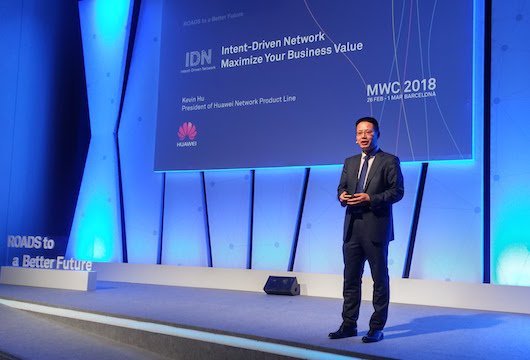
Huawei launched a new network product at Mobile World Congress 2018 on Monday that aims to convert SDN networks into “intent-driven” networks.
That may sound like Huawei attempting to coin an industry term based on its own proprietary technology – and to a point that may be the case. But what Huawei is proposing with its “intent-driven network” (IDN) solution is essentially to take the concept of app- or service-centric bandwidth on demand (and whatever SLAs may apply) and add AI, big data and cloud technologies to it, which enables the network to not only know – or even predict – the type of app or service a customer wants to use and the context in which they want to use it, but to do so automatically.
At a media event, Kevin Hu, president of Huawei’s network product line, said the IDN solution can enable networks to become user-centric to the point of delivering the experience the user expects.
“Intent-driven networks can accurately read a user’s intention, and make it happen, because network configuration is automated from end to end. These networks can also sense the quality of the user experience in real time, and perform predictive analysis so that they can proactively optimize performance.”
According to Hu, the IDN solution does this by “creating a digital twin of the network infrastructure” via four different network cloud-based engines.
Key features of the IDN solution include predictive analysis, greater simplicity (in terms of architecture, protocols, base stations, and O&M), support for ultra-broadband technologies, open API interfaces that enable it to connect to third-party big data analytics and cloud platforms, and the ability to spot and proactively prevent security threats.
The reason operators need IDN, Hu says, is because they’re under increasing pressure to deliver better customer experiences, particularly in the areas of fast service provisioning, keeping network downtime to a minimum, and ensuring that every link in the service chain is working optimally and not affecting service quality. Current O&M systems can’t deliver that because they’re designed for physical equipment.
Huawei envisions a range of apps that can benefit from IDN – 5G bearer networks (think user-aware network slicing), home broadband networks, enterprise private lines, campus networks, data center networks, IP and optical transport networks and security.
The IDN was one of a deluge of new products announced by Huawei at MWC 2018.
Also on Monday, Huawei officially unveiled its full end-to-end Release 15-compliant 5G equipment portfolio covering the core network, bearer network (for fronthaul and backhaul), base stations (from macro to small cells) and terminals.
The terminal isn’t a smartphone but a CPE device for wireless home broadband services – which reflects the fact that the initial services for most of the first commercial 5G rollouts based on Release 15 will be enhanced mobile broadband and fixed wireless access, said Yang Chaobin, president of Huawei’s 5G product line.
The 5G CPE supports C-band and mmWave, and is capable of data speeds up to 2 Gbps.
Yang added that Huawei intends to launch its first 5G smartphone sometime next year, which will be able to handle speeds up to 5 Gbps.
Huawei also unveiled its latest high-end intelligent all-flash array (AFA) –the OceanStor Dorado 18000 V3 – which promises to help customers manage storage resources for mission-critical enterprise services with intelligence and ensures consistent service experience on- and off-premises. Joy Huang, VP of Huawei’s IT product line, said the AFA is the fastest in the land (7 million IOPS at 0.5 ms consistent latency) and supports HyperMetro active-active technology to ensure key services keep running 24/7.

Be the first to comment